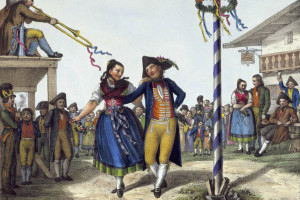The Law of Non-‐Contradiction states that it isn’t possible to be both Y and Not-‐Y at the same time—which suggests that the law never encountered May Day, the public holiday celebrated on May 1, which both is and isn’t a celebration of summer. May Day owes its origins to the ancient festivals—from the Roman Floralia to the Celtic Beltane—that celebrated the first plantings of the season and the coming of the solstice.
May Day owes its origins to the ancient festivals—from the Roman Floralia to the Celtic Beltane—that celebrated the first plantings of the season and the coming of the solstice.
By the end of the Middle Ages, the day had become one of the most important on the calendar. Just as the fir tree has become a popular symbol of Christmas, the flowering hawthorn—also called the May tree—became the sacred emblem of summer. (When Shakespeare wrote, “Rough winds do shake the darling buds of May” in his famous Sonnet 18, he meant the tree, not the month.)






